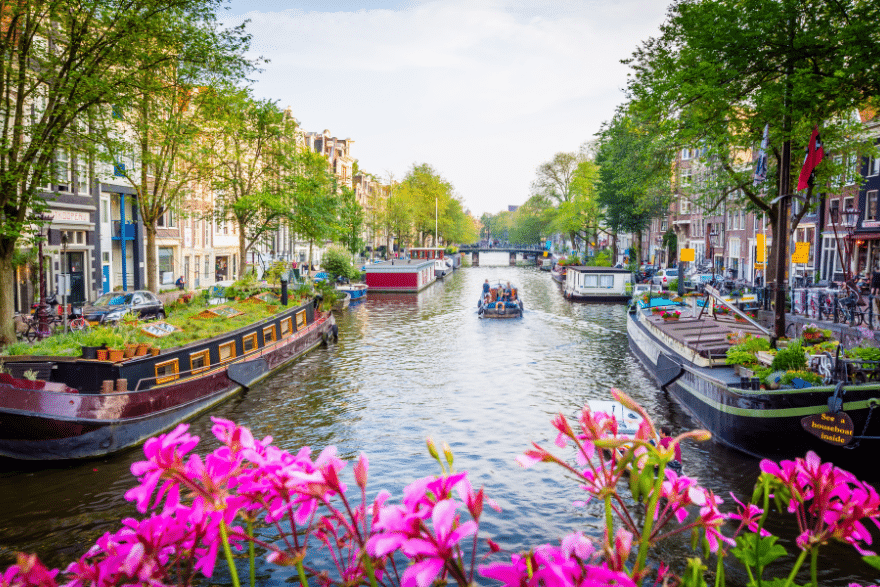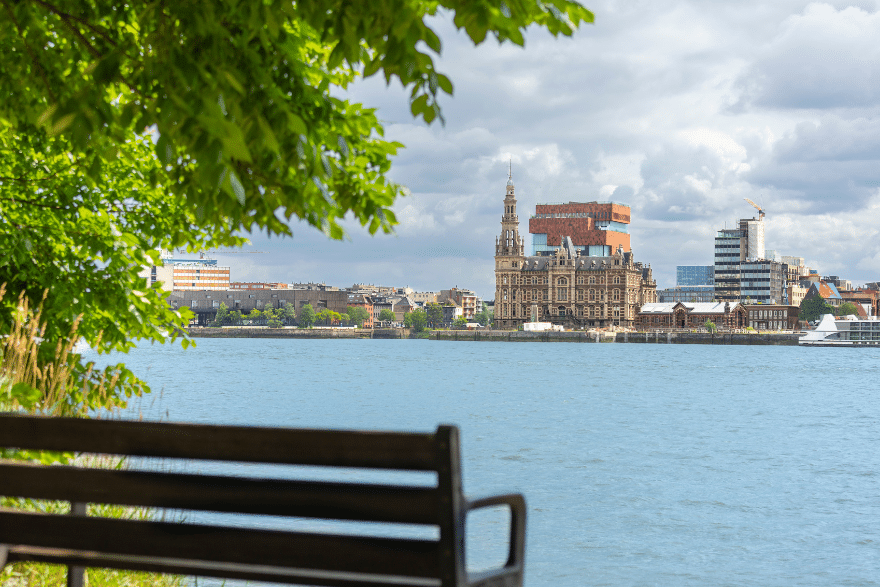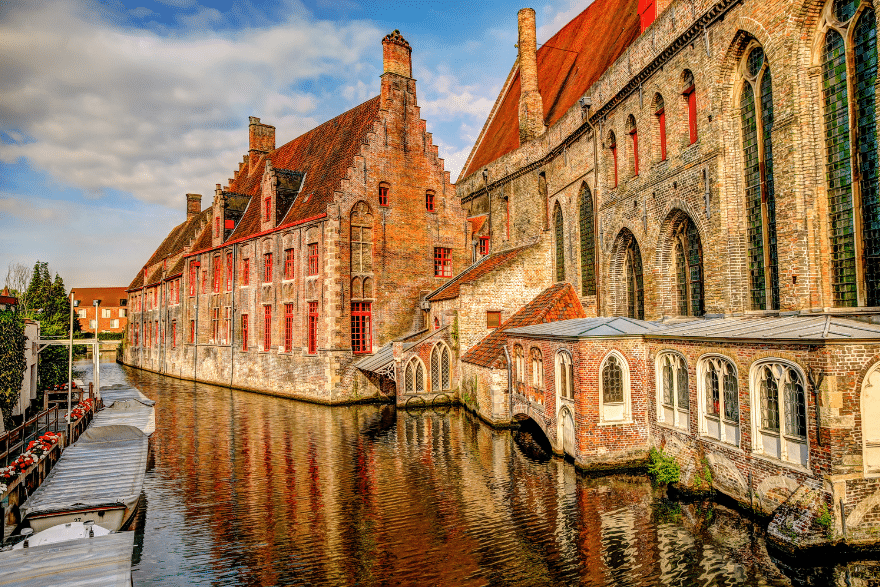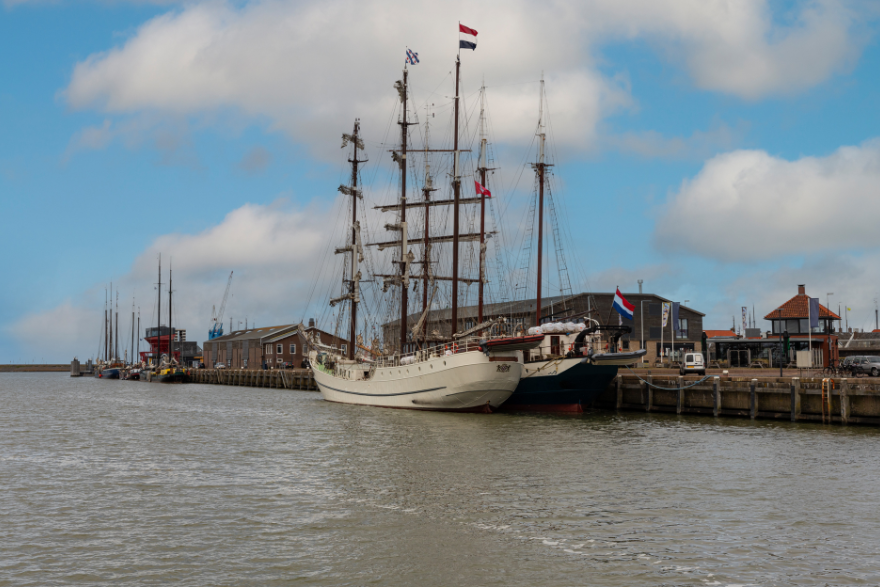Reds bleed into pinks, purples complement blues, and oranges meet fiery golds. Once a year, from mid-March to mid-May, the Netherlands and Belgium become drenched in natural colours. Such is the brilliant beauty of tulip season. The vibrancy of the colors is reason enough to plan to visit in the Spring.
Which also helps illuminate Windstar’s 7-day Tulip Season in Holland & Belgium journey aboard Star Pride, departing from Amsterdam, home to the annual Amsterdam Tulip Festival, on April 21, April 28 and May 5, in 2026. Amsterdam gives way to Dutch town Harlingen, followed by futuristic Dutch metropolis Rotterdam, medieval Belgian city Bruges, and Belgium’s stylish Antwerp. Each of which will be adorned by tulips, to varying degrees, at this time of year.
“Our tulip season itinerary has the same appeal as a river cruise,” says Ricky Trautwein, Windstar’s product manager for western Europe. “The cruise is a week long, and your ship is a floating resort that transports you to each port of call. Whether you’re planning to explore independently or take advantage of our range of shore excursions, from culinary and cycling to of course, tulip garden visits, it’s a wonderful way to experience this delightful region.
For those wondering why these neighboring nations are so intertwined with tulips, the answer is in their gentle climates. That’s because they are rarely too cold, rarely too hot, and close to the coast. These give tulips an amenable home and watch them blossom.
The best-known tulip fields are Keukenhof and Lisse. Located midway between Amsterdam and the Hague, these neighbouring areas boast literally millions of tulips and are easily accessible. So, too, are the Dutch tulip spots of Noordoostpolder, Overijssel and Kop van Noord-Holland, and the Belgian fields of Groot-Bijgaarden Castle, and Koningskieldrechtpolder. Some can be explored by bike, others on foot, and many allow visitors to handpick their own tulips, for a price.
“What really surprised me is the variety of cities – from the super-modern Rotterdam, to Belgium with its French influences,” Trautwein tells me. “Ghent used to be one of the power house cities back in the day, a university town, and it is super-cool to see how it mirrors both its grand history and its contemporary vibe. And, exclusive to Windstar, from Amsterdam we’ll take you to a tulip farm where you can pick your own tulips and bring your bouquet back on board. I can’t wait to return to Belgium and the Netherlands at any time of the year.”
Whichever time you visit the Netherlands or Belgium, there’s so much else to see

And here’s the thing about cruising in this part of Europe: While Belgium and the Netherlands are famed for its tulip experiences, which are unsurpassed by any other European nation, don’t overlook its array of other alluring activities, landmarks and attractions. In Amsterdam, impressive art galleries, majestic city squares, splendid parks, charming canal neighbourhoods, and an extraordinary trove of more than 600 museums, including the world-renowned Rijksmuseum.
Belgium, too, has myriad appealing attributes beyond its tulip displays. Antwerp seduces with its chocolate, beer, art galleries and heritage fort, while Bruges, with its medieval splendour, feels as if AI (artificial intelligence) was asked to concoct a picture-perfect, old-world European city.
Here’s our rundown on what to know, see and do in Belgium and Netherlands’ ports of call – whichever time of the year you visit.
First, some tulip fun facts

- Tulips did not originate in Belgium or the Netherlands. Instead, the flower grew in Central Asia, as a wildflower and, more specifically, came from Turkey. It got its name from the Turkish word for turban and, to this day, there’s an annual Istanbul Tulip Festival every spring.
- Tulips were introduced in the Netherlands in the 16th century and the Dutch were besotted: According to the University of Oxford, “the introduction of tulips to Holland in the latter part of the sixteenth century coincided with the fashion for the newly emergent middle and upper classes to keep gardens.”
- Tulips have cultural significance, symbolizing love, new beginnings and rebirth – and their meaning changes with their colors. White tulips signify forgiveness, respect, purity and honor. For a truly romantic gesture, send a bouquet of red tulips instead of roses; both indicate romantic love. An orange blossom points to energy and enthusiasm and purple, considered extravagant because the color’s die was so expensive, evokes royalty.
Amsterdam

Antwerp’s demise earned Amsterdam a prize. Amsterdam began as a fishing village in the 1300s, grew into a small city across the 1400s, and then boomed from the late 1500s due to the misfortune of Antwerp, which Spanish forces seized in 1585. The Dutch responded to Belgium’s crisis by blocking access to its own busy port. This caused most of Antwerp’s maritime trade to shift to Amsterdam port. Amsterdam exploded in size and wealth across the following centuries, as Dutch ships departed its port on global missions to expand the Netherlands empire.
Tulip season hotspots:
This might surprise you: Giant fields of tulips aren’t found in the city of Amsterdam and yet you won’t go without because do get planted in the city center in gardens, pot plants, on windowsills. Vibrantly colorful blooms decorate business and embellish Amsterdam’s verdant parks, such as the one mile-long Vondelpark, where hundreds of glossy tulips sprout beside its pretty ponds and lush lawns. And don’t miss the Bloemenmarkt, a floating flower market; it’s home to the Amsterdam Tulip Festival.
Beyond the tulips:
Amsterdam is designed to be pierced by boats and traversed by bicycles. Yet it is also very walkable, thanks to its more than 1,500 bridges, which ensure you’ll stride over, not into, the city’s seemingly endless canals. Exploring by foot will expose you to the vices famously peddled in Amsterdam. Smell the pungent smoke wafting from its unique marijuana cafes, and witness escorts standing behind windows in its red-light district.
But Amsterdam isn’t just about tulips, intoxication, and titillation. The Dutch also cherish creativity. Which explains why Amsterdam has more cultural facilities per capita than any other city, according to a recent study. The colossal Rijksmuseum, reputedly Europe’s fifth-largest museum, relays the story of 800 years of Dutch history and art, and showcases paintings by Dutch masters like Vermeer, Rembrandt and Van Gogh.
The latter pair have their own dedicated museums, too, with Van Gogh’s set inside his stately former home. As does Anne Frank, the Jewish girl whose tragic diary of her family’s two years hiding from the Nazis in an Amsterdam home is one of the most widely read books in history.
Just 600m east of Anne Frank House lays the city’s magnificent main plaza, Dam Square. Here tourists can enter the magnificent Royal Palace Amsterdam, where the Dutch royal family hosts galas and world leaders. As well as its hulking 15th century church, De Nieuwe Kerk, which now hosts exhibitions on history, art and photography.
Rotterdam

How much can change in the space of just 35 miles? A great amount, it turns out, as exemplified by Rotterdam, which is that same distance from Amsterdam, yet feels like it’s on a different continent. Whereas Amsterdam is low rise and brims with heritage buildings, Rotterdam has a lofty skyline spiked by gleaming towers, which makes it more closely resemble a modern city in the US or Australia.
The reason for this is 15 minutes of bloody bedlam. On May 14, 1940, at the peak of WWII, the historic city of Rotterdam was all but erased by a very brief yet catastrophic bombing campaign by the Nazis. Over the following decades it was rebuilt in a new image, which Rotterdam embraced by investing in hyper-modern architecture.
Tulip season hotspots
Similar to Amsterdam, the streets and parks of Rotterdam are flecked by tulips during their season. But truly memorable blankets of blossoms can only be admired in its surrounding countryside. Tulips abound on Goeree Overflakkee, a sparsely populated island rich with meadows and beaches, some 12 miles south of Rotterdam. Meanwhile, hectares of tulip fields dazzle visitors to Noordwijk, a serene coastal town 20 miles to the north. Keukenhof and Lisse, meanwhile, are only slightly further away.
Beyond the tulips
Pause the diet to devour a caramel stroopwafel while sat beneath a shady sycamore tree in Rotterdam’s lovely Het Park. Then erase those calories by hitting the pavement. Join Windstar’s architecture tour to witness the hyper-modern appeal of Rotterdam Centraal station, and the pleasing extravagance of Market Hall, which from outside looks like a grey, metallic space station, and yet inside has a playful interior drenched in colour and swirling patterns.
Rotterdam is also the gateway to one of the Netherlands’ most revered exports. Just to its north is the small city of Delft, which since the early 17th century has produced Delft Blue, a highly sought-after form of earthenware, which features delicate blue patterns on white ceramics. At Royal Delft, Windstar guests can visit this city’s last Delft Blue store, called Porceleyne Fles, to do a factory tour, and experience a ceramics lesson.
Antwerp

Antwerp’s fortunes have long mirrored that of its port. When it became a hub of maritime trade in the 14th century, this Belgian city blossomed, with seamen landing here to be dazzled by Antwerp’s stately appearance. Nowadays, Antwerp’s port is not only the second-busiest in all of Europe, but the city still makes an impression via its architecture.
As cruise ships approach this Belgian city, along the calm Schelt River, guests witness an avant-garde marvel spawned by a genius. The Antwerp Port Authority building was converted from a derelict fire station into a brash building that melds heritage with the cutting edge. One of the greatest architects in history, Iranian-British star Zaha Hadid chose to renovate the charming old station, and then build a sharp-angled, giant glass box on top. It is a fitting way to crown Belgium’s lucrative port.
Tulip season hotspots
Rubenshuis is the epitome of quality over quantity. It may not have the vast tulip fields many tourists covet, but each April its hundreds of blossoms own a splendid backdrop, adding colour to the manicured gardens of this 17th-century Antwerp mansion turned art museum.
Tulips bloom in greater numbers at nearby Hortus Conclusus, which means “enclosed garden” in Latin. Up to 5,000 tulips, consisting of more than 100 varieties, blanket this walled garden, alongside Antwerp’s handsome St George’s Church.
Beyond the Tulips
Antwerp is simply gorgeous. Many non-Europeans are guilty of lumping this continent’s cities together, labelling them all as lovely. But there are levels to such beauty, as Antwerp makes patently clear. It is easy to find yourself wandering around staring, in appreciation, at the elegant Neoclassical and baroque architecture that embellishes this wonderfully well-preserved city.
Cycling is a great way to explore the city. Similar to the walking tours offered by Windstar, the cycling adventures reveal downtown Brussels’ finest attractions. Don’t miss places include the lavish Grand Place plaza, the Gothic wonder that is the Cathedral of our Lady, Antwerp’s ancient Het Steen fort, and the futuristic MAS Museum, which focuses on the city’s history.
Driving tours, meanwhile, stray further afield, to the Royal Castle of Laeken, King Boudewijn Stadium, the Centenaire exhibition halls, and Brussels’ quirky Atomium, a museum designed to resemble a molecule.
Bruges

Many cities contain UNESCO World Heritage sites. But very few cities are so remarkable that their entire historic centre earns UNESCO status. Bruges is one such metropolitan unicorn. UNESCO calls Bruges an “outstanding example of a medieval historic settlement, which has maintained its historic fabric as this has evolved over the centuries.”
Bruges’ medieval city is pierced by canals, connected by cobblestone streets, and enhanced by hundreds of memorable brick Gothic buildings. Originally it was protected by 12th century city walls, the remains of which now include ramparts, four hulking gates, and a water tower.
Tulip season hotspots
Bruges has no elite tulip spotting locations. But for a truly impressive experience, take a day trip 50 miles’ east to the spacious grounds of Groot-Bijgaarden Castle, where tens of thousands of tulips show off during its annual Floralia Brussels, from April 3 to May 3. Or head 40 miles’ east to the vast tulip fields of Koningskieldrechtpolder in Meerdonk.
Beyond the Tulips
Belgian beer is almost as alluring as Bruges itself. So it makes sense to pair them, as Windstar does during its excursion to this city’s long-running Bourgogne des Flandres brewery. At this downtown facility, guests learn this company’s unique process for blending young and old beers to produce its two varieties of beer.
Key sights to see in Bruges include its medieval city center, which is a UNESCO World Heritage site, its Markt (Market Square) and the Belfry of Bruges, where you can climb its tower for a panoramic city view. Groeningemuseum features six centuries of Belgian visual arts, including a major collection of Flemish primitive art. And a canal cruise through Bruges’ iconic waterways offers a fresh perspective on this lovely city.
If beer isn’t your thing, don’t fret; Bruges is also famous for its chocolate and waffles, and opportunities to experience these forms of the culinary arts are available via shore excursions and independent exploring.
Harlingen

You almost need a magnifying glass to spot Harlingen on a map of Europe. This Dutch town of about 15,000 people is tiny compared to the other ports on this itinerary. Yet Harlingen captivates with its rollicking maritime history, well preserved architecture, picturesque New Willemshaven harbour, and easy access to the Netherlands’ unique Wadden Sea.
At that latter port, where cruise ships dock, visitors can admire towering tall ships and historic vessels used by famed Dutch explorers. Echoing across their decks are engrossing tales of bold expeditions. Such as the three unsuccessful missions to find the Northeast passage by 16th century seamen Willem Barentsz, who froze to death in the Arctic, but whose ship remains here.
Tulip season hotspots
Near to Harlingen is the biggest continuous flower bulb area on the planet. Named Kop van Noord-Holland, this corridor of fertile land is flanked by Ijsselmeer Lake and receives a mere smattering of visitors compared to the Netherlands’ top tulip spots, the world’s largest, continuous area of flowering bulbs. Field after field, blossom after blossom, hue after hue, this is a place tailormade for photography, and for burning indelible memories.
Beyond the Tulips
Tiny? Yes. Irrelevant? Not at all. Harlingen punches several classes above its weight when it comes to attractions. In fact, so much so that this tranquil town on the Netherlands’ central coast is connected to not one, not even two, but three UNESCO sites.
Directly offshore lies the Wadden Sea, the world’s biggest unbroken system of intertidal mud and sand flats. This UNESCO wonder, which is home to seals and porpoises, stretches more than 400km (about 250 miles) north from here to Denmark, past fauna-rich estuaries, neat beaches, vast salt marshes, and dramatic dunes.
UNESCO also protects Woudagemaal, about 20 miles south of Harlingen. Granted, a steam pumping station may not sound particularly exciting. Yet Woudagemaal is not only the world’s oldest such facility, dating to 1920, but visitors can enter this still-functioning facility to learn how its hydraulic powers pump away excess water, and prevent its surrounding areas from flooding.
Much closer to Harlingen is another UNESCO site, Franeker Planetarium. Some four centuries ago, this extraordinary creation fell out of the sky. Not literally, of course, or this heavy, mechanical scale model of the solar system would have dug a trench in the Dutch town of Franeker, 3 miles east of Harlingen. Rather, this ingenious creation arrived in the world as a surprise, back in 1781. It was a surprise because it was built by a wool manufacturer, rather scientists or university researchers.




















































